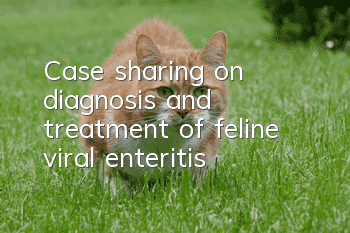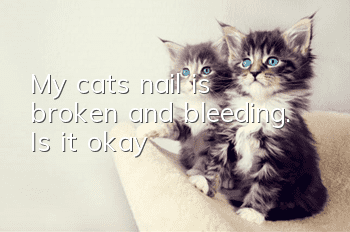Case sharing on diagnosis and treatment of feline viral enteritis

In July 2015, our hospital cured feline viral enteritis. Based on the clinical symptoms and epidemiological investigation of the affected animals, combined with the treatment effect, it was initially diagnosed as viral enteritis caused by canine microvirus (MCV) infection. Since there are few cases of feline viral enteritis caused by this virus, this article will share with you the diagnosis and treatment of this case.
1. Situation of sick animals
This cat is an ordinary domestic cat. It receives the imported cat triple vaccine every year. It has no history of infectious diseases, is in good nutritional status, has a strong body, and just gave birth to cubs last year.
2. Clinical symptoms
The sick cat suddenly became ill and began to show sticky, loose and loose stools. The next day, he had bloody stools. The stools were tomato juice-like with blood, fishy smell, depression, decreased appetite, and then refused to eat. He came to the hospital for a physical examination with a body temperature of 40 Above Celsius, the mucous membrane may appear pale. No pathogenic bacteria were found in stool sampling and culture, and the white blood cells in routine blood tests were below 5.
3. Diagnostic impression
Based on the epidemiological investigation results, clinical symptoms of sick animals and treatment effects of sick animals, as well as identification and analysis of several suspicious virus characteristics, MVC virus infection was initially suspected.
MVC is a member of the Bocavirus family of the genus Parvovirus. Currently known members of Bocavirus include bovine Bocavirus, canine Bocavirus, human Bocavirus, and the newly identified porcine Bocavirus, as well as new Bocavirus members found in orangutans, cats, dogs, and California sea lions. There is data confirming that MCV can cause disease in cats. In terms of viral properties, antisera against CPV cannot neutralize MCV, but antisera against MCV cannot neutralize CPV. CPV is closely related to FPL in terms of antigenicity. Both FPL's attenuated vaccine and inactivated vaccine can protect dogs against the strong virus of CPV. Theoretically, cats immunized with FPL should no longer develop CPV disease. In addition, serum neutralization, hemagglutination inhibition and immunofluorescence tests clearly showed the close relationship between CPV and FPL viruses. In previous work, I have encountered similar diseases and used CPV and CDV hyperimmune serum for treatment, but no therapeutic effect was seen. This characteristic may also be one of the reasons why CPV-like infections appear in clinically CPV-immunized animals, and such infections are most likely to be MVC infections.
4. Clinical treatment
The treatment principles are mainly anti-viral, hemostatic, maintaining body fluid balance and preventing infection.
Rx: intravenous infusion
5% glucose injection 100ml + ampicillin and sulbactam sodium 0.5g
5% Glucose Injection 100ml+ATP20mg+CoA100u+Vc0.25g
10% Glucose Injection 50ml + Hemostasis 0.5g
5% sodium bicarbonate 10ml
Intramuscular injection
Polysarcoma (interferon) 2mg
Treat once a day for 5 consecutive days.
Oral administration
Gentamicin 40,000 u
During the treatment process, pay close attention to the changes in the animal's condition. If the body temperature exceeds 39.5 degrees Celsius, intramuscular injection of 1ml of Bupleurum barbiturum will be better. If the body temperature exceeds 40 degrees Celsius, the intramuscular injection of compound ammonia barbiturate will have better results. Animals will generally vomit during the treatment. If the vomiting is severe, metoclopramide may be injected intramuscularly to stop vomiting. Atropine may also be injected to stop vomiting. After the animal refuses to eat for 4 days, in order to ensure the necessary metabolic requirements of the animal's body, add 100 ml of 5% glucose injection and one water-soluble vitamin injection to the infusion. Try to feed the animal after 3 days of treatment. You can use the cat food, Miaoxianbao, snacks, etc. that the animal usually likes to eat to stimulate the animal's appetite. If the animal has vomiting behavior, delay feeding, but follow up in time on energy supplement. You can Give appropriate amino acid and other infusion supplements.
5. Disease prevention
MVC has strong resistance to the outside world and is extremely contagious. Once the disease occurs, the sick cat should be quickly isolated, and the feeding equipment, utensils, and transportation vehicles contaminated by the sick cat should be strictly disinfected. The disinfectant can be 3% sodium hydroxide, bleaching powder, hydrogen peroxide, etc. Ultraviolet irradiation can be used for machine disinfection. Healthy animals cannot be kept in a poisonous environment for half a month. People who have close contact with sick cats should strictly pay attention to their own disinfection measures to avoid indirect infection of other animals.
Vaccine immunization is the fundamental measure to prevent MCV. However, immune failure cannot be ruled out, which is related to vaccine quality and immune interference. The main reasons are improper selection of vaccine strains and interference from maternal antibodies. The vaccine should be an imported vaccine with reliable quality. The first vaccination time is generally considered to be around 45 days of age. Considering that kittens are also susceptible to the age before 10 weeks, the vaccine should be injected early, and the six-part vaccine should be injected at 60 days of age. Inject the six-combination vaccine once every 2 weeks for 3 consecutive times, and then be vaccinated once a year.
6. Treatment experience
6.1 It is clinically found that cats or dogs excrete dark gray porridge-like stools. If the food type factor can be ruled out, viral infectious diseases should be suspected first, and broad-spectrum antiviral drugs combined with anti-inflammatory drugs should be applied promptly and in sufficient amounts. Early broad-spectrum The application of antiviral drugs can significantly shorten the course of treatment and improve the clinical cure rate.
6.2 Use hemostatic drugs early. When viral enteritis occurs in cats and canines, gastrointestinal bleeding occurs quickly. In some medical records, a rotten tomato-like stench appears on the second day after the onset of the disease.Convenience. Therefore, the application of hemostatic drugs at the onset of the disease is also of decisive significance in the treatment of this disease.
6.3 The importance of maintaining body fluid and electrolyte balance. During the onset of this disease, vomiting and diarrhea are common typical symptoms, so the loss of body fluids is mainly in the gastrointestinal tract, and is mainly hypotonic dehydration or isotonic dehydration. For liquid preparation, an isotonic solution of sugar, salt, and alkali can be prepared in a ratio of 2:2:1 to avoid hyperchloric acidosis.
6.4 In order to prevent other concurrent infections and neutralize toxins in the body during treatment, appropriate antibiotics and intravenous injection of a large amount of Vc have a certain effect on controlling infection, preventing shock, and neutralizing toxins in the body.
- How to deal with a fight between two male cats. Don’t rush into each other.
- How many months can it take for a kitten to have its ears cleaned?
- What are the symptoms of dehydration in cats?
- How to deal with kitten odor
- Diarrhea in kittens has never been good
- Do cats need to be dewormed before vaccination?
- Do cats hate someone?
- What happens if a cat licks catnip too much?
- Will Fat Orange recognize its owner?
- How to tell if a kitten can eat cat food



